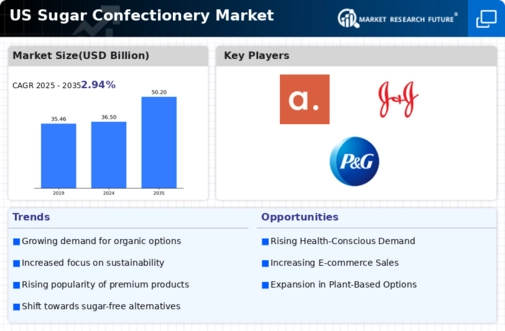Seasonal and Festive Demand
Seasonal events and holidays play a crucial role in driving sales within the sugar confectionery market. During occasions such as Halloween, Christmas, and Valentine's Day, there is a notable spike in demand for confectionery products, as consumers indulge in festive treats. For instance, in 2025, it is estimated that seasonal sales could account for nearly 30% of total annual revenue in the sugar confectionery market. This seasonal demand encourages manufacturers to develop limited-edition products and themed packaging, which not only enhances consumer engagement but also boosts brand visibility. As such, companies that effectively capitalize on these seasonal trends are likely to see substantial growth and increased market share.
Evolving Consumer Preferences
The sugar confectionery market is currently experiencing a shift in consumer preferences, with a growing inclination towards indulgent treats that offer unique flavors and experiences. This trend is particularly evident among younger demographics, who are increasingly seeking out artisanal and gourmet options. As a result, manufacturers are innovating to create products that cater to these desires, leading to a diversification of offerings within the sugar confectionery market. In 2025, the market is projected to reach approximately $40 billion, reflecting a compound annual growth rate (CAGR) of around 3.5% over the next five years. This evolution in consumer tastes suggests that brands must adapt their strategies to remain competitive and relevant in the ever-changing landscape of the sugar confectionery market.
Innovative Marketing Strategies
In the competitive landscape of the sugar confectionery market, innovative marketing strategies are becoming increasingly vital for brand differentiation. Companies are leveraging social media platforms and influencer partnerships to reach younger audiences, who are more inclined to share their experiences with confectionery products online. This approach not only enhances brand awareness but also fosters a sense of community among consumers. Furthermore, the use of targeted advertising and personalized promotions is expected to increase engagement and drive sales. As the market evolves, brands that effectively harness these innovative marketing techniques may gain a competitive edge, potentially leading to increased market penetration and revenue growth in the sugar confectionery market.
Sustainability and Ethical Sourcing
Sustainability is emerging as a key driver in the sugar confectionery market, as consumers become more conscious of the environmental and social impacts of their purchases. Brands that prioritize ethical sourcing of ingredients and sustainable packaging are likely to resonate with eco-conscious consumers. In 2025, it is anticipated that nearly 25% of consumers will actively seek out products that align with their values regarding sustainability. This shift presents an opportunity for manufacturers to innovate and differentiate their offerings, potentially leading to increased loyalty and market share. As the sugar confectionery market continues to evolve, those companies that embrace sustainable practices may find themselves better positioned to meet the demands of a changing consumer landscape.
Technological Advancements in Production
Technological advancements are playing a pivotal role in shaping the sugar confectionery market, as manufacturers adopt new production techniques to enhance efficiency and product quality. Innovations such as automation and precision manufacturing are enabling companies to reduce costs while maintaining high standards. Additionally, advancements in food technology are facilitating the development of healthier alternatives, such as sugar-free or reduced-calorie options, which cater to the growing health-conscious segment of consumers. As these technologies continue to evolve, they are likely to drive competitiveness within the sugar confectionery market, allowing brands to respond more effectively to consumer demands and preferences.














Leave a Comment